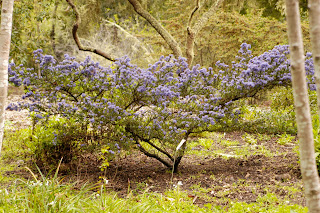 |
| Jan Stewart, gardener |
The nursery was founded in 1960 by Gerda Isenberg, a pioneer in the native landscape movement. On her family's 3,000-acre cattle ranch, Gerda built a nursery dedicated to natives, many of them are today rare or endangered in the wild.
I'll let you in on our conclusions in a minute. In the meantime, here are some images of what we saw as we walked the garden in early spring.



The good folks at Yerba Buena (means good herbs in Spanish) say there are many reasons to grow native plants. They're diverse and beautiful, hearty in their native climates and, perhaps most importantly, they create a sense of place, a homey normalcy. It's what we talk about when we talk about California. And, native wildlife usually make themselves right at home, which is only natural. The nursery includes more than 600 species of plants, all grown from seeds, cuttings and divisions.
Over petite fours and hot tea on a blustery spring afternoon, we enjoyed the sweeping view from the farm house dining room, done up in chintz and roses. Here's what Jan and I decided. Everything they say about native plants is true: they're beautiful, drought tolerant, attract beneficial wildlife and provide a unique sense of place. But . . . You knew there'd be a but. Wild and leggy, native plants don't provide the sculpted, multi-dimensional richness of an intentional garden. They can be planned into tough spots where more delicate non-natives don't thrive.
But, natives are not indestructable. I brought an aromatic shrub home, planted it in an unshaded front bed in my garden and it promptly keeled over. Another tip, find a local native plant nursery that sells species suited to your own micro-climate. I saw many ferns and delicate flowering plants perfect for coastal growing areas, but unsuited to Sacramento's blistering summers and heavy clay soils. There was much at Yerba Buena that just won't work in my garden.
Decorative gardens need native touches and accents, we decided, sometimes in stronger measure than others, depending on the design and environmental conditions. But to feed the spirit and calm the soul, a well-designed garden calls for more than just going native from top to bottom.
 If you've got thoughts about using native plants in ornamental gardens or have photos of natives showing how they're used, please submit them through the comment box on this blog. We'd love to see how you've incorporated natives into your own garden. Let's take a look.
If you've got thoughts about using native plants in ornamental gardens or have photos of natives showing how they're used, please submit them through the comment box on this blog. We'd love to see how you've incorporated natives into your own garden. Let's take a look. 









No comments:
Post a Comment